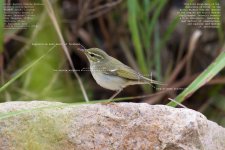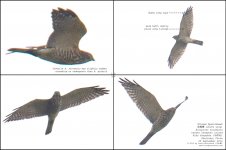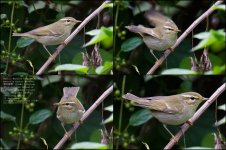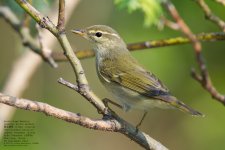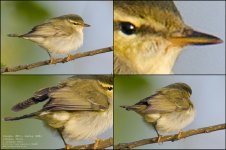-
Welcome to BirdForum, the internet's largest birding community with thousands of members from all over the world. The forums are dedicated to wild birds, birding, binoculars and equipment and all that goes with it.
Please register for an account to take part in the discussions in the forum, post your pictures in the gallery and more.
You are using an out of date browser. It may not display this or other websites correctly.
You should upgrade or use an alternative browser.
You should upgrade or use an alternative browser.
China Birding Notes (1 Viewer)
- Thread starter thrush
- Start date
More options
Who Replied?A. platyrhynchos
Member
Craig, I agree with your IDs. I guess it is not possible to exclude neither Kamchatka nor Japanese Leaf Warbler on field characters alone, although a Japanese would probably be more yellow. The wing tip on Chinese Sparrowhawk appears more pointed than in Japanese Sparrowhawk, which can be noticed in the pictures with spread wings.
rockfowl
Mark Andrews
I don't think that it is possible to visually separate the Arctic complex except to perhaps give you a hint to pay more attention if you had a particularly yellow bird for example PH and TT's Dalian bird. However this years Beidaihe Kamchatka looked just like a borealis, PH found it on call I believe, sadly I couldn't find it the next day.
Note the 4 visible fingers on your Chinese, Japanese usually 5, Eurasian 6
Note the 4 visible fingers on your Chinese, Japanese usually 5, Eurasian 6
Jeff Hopkins
Just another...observer

Note the 4 visible fingers on your Chinese, Japanese usually 5, Eurasian 6
That is a great field mark! I'll have to remember that one.
rockfowl
Mark Andrews
That is a great field mark! I'll have to remember that one.
Its not quite as easy in the field but it does help.
Chinese - http://orientalbirdimages.org/birdi...cies&Bird_ID=895&Bird_Family_ID=96&pagesize=1 & http://orientalbirdimages.org/birdi...cies&Bird_ID=895&Bird_Family_ID=96&pagesize=1
Japanese - http://orientalbirdimages.org/search.php?p=8&Bird_ID=905&Bird_Family_ID=&pagesize=1 & http://orientalbirdimages.org/search.php?p=11&Bird_ID=905&Bird_Family_ID=&pagesize=1
Eurasian - http://orientalbirdimages.org/search.php?p=15&Bird_ID=898&Bird_Family_ID=&pagesize=1 & http://orientalbirdimages.org/search.php?p=27&Bird_ID=898&Bird_Family_ID=&pagesize=1
A. platyrhynchos
Member
Thanks for pinting that out Mark! I should have written it more precisely... 
thrush
Craig Brelsford (大山雀)
I don't think that it is possible to visually separate the Arctic complex ...
Thanks for reinforcing the point that we can't separate the Arctic Complex visually. In that vein, I have something special for you, Mark, and for all leaf-warbler lovers out there. Attached to this message is a recording of an Arctic-type Warbler and a four-panel image of the same bird. (It's a 100% certainty that the bird in the photo and the bird in the recording are one and the same.)
The photo in the top-left panel was taken 3 seconds before the other three, which were taken within the space of 1 second. In the top-right panel, the bird is wing-flicking; it's not about to take flight. It probably wanted to get a better look at me and so interrupted its foraging in the undergrowth.
The material was created on Sat. 20 Sept. 2014 on Lesser Yangshan Island, off the coast of Shanghai.
From my report on last weekend's trip, here are my notes on the encounter with this bird:
Viewed this individual for about 5 mins. skulking energetically in short, thick vegetation. From a range of at times as little as 2 m, I sounded-recorded its regularly emitted "chik" or "tik" call. I also photographed its entire body when it made a rare appearance on an exposed branch. I compared the recording of the call with recordings downloaded from xeno-canto.org of Arctic Warbler (Phylloscopus borealis borealis and P. b. kennicotti), Kamchatka Leaf Warbler (P. examinandus), and Japanese Leaf Warbler (P. xanthodryas). The calls are much different from those of superficially similar species such as Two-barred Warbler. I therefore can confidently place this bird within the Arctic Warbler Complex, even if I can't determine to which of the taxa in the complex the bird in question belongs.
Once at home, my problem was that on xeno-canto.org, recordings of P. xanthodryas and P. examinandus are rather scarce. Despite my desire to nail an ID of a difficult leaf warbler in the fall, I held back and held my ID at the Arctic Warbler Complex level.
To Mark (and all you other leaf warbler lovers): with the image, recording, and description at your disposal, perhaps we can nail down the ID--or at the very least learn something!
... Note the 4 visible fingers on your Chinese, Japanese usually 5, Eurasian 6
Great tip, and not found in the sources I checked. I'll remember that one.
Attachments
Last edited:
rockfowl
Mark Andrews
Mmmm Interesting!
I think you need to put this recording through some software and get a sonogram. I personally can't rule out a Kamchatka from this recording as it sounds rather similar (some borealis also, if they are correct), though others may disagree eg Paul Holt, Per Alstrom etc whose listening skills are far better than mine. It will probably need cleaning up slightly, sounds like an Asian Stubby calling in the background amongst other species.
Plumage wise it looks like a borealis but having heard about the Beidaihe Kamchatka record this year and having seen a few images (which may of course not be the right bird, I wasn't there), I'm no longer sure.
It certainly doesn't look like China's first modern record , this buffy toned individual found by Terry and Paul - http://birdingbeijing.com/2012/05/14/kamchatka-leaf-warbler/
Some useful recordings to compare here on Per Alstrom's site - http://www.slu.se/sv/centrumbildnin...roms-forskning/arctic-warblers-vocalizations/
I think you need to put this recording through some software and get a sonogram. I personally can't rule out a Kamchatka from this recording as it sounds rather similar (some borealis also, if they are correct), though others may disagree eg Paul Holt, Per Alstrom etc whose listening skills are far better than mine. It will probably need cleaning up slightly, sounds like an Asian Stubby calling in the background amongst other species.
Plumage wise it looks like a borealis but having heard about the Beidaihe Kamchatka record this year and having seen a few images (which may of course not be the right bird, I wasn't there), I'm no longer sure.
It certainly doesn't look like China's first modern record , this buffy toned individual found by Terry and Paul - http://birdingbeijing.com/2012/05/14/kamchatka-leaf-warbler/
Some useful recordings to compare here on Per Alstrom's site - http://www.slu.se/sv/centrumbildnin...roms-forskning/arctic-warblers-vocalizations/
Last edited:
A. platyrhynchos
Member
Unfortunately, the call does not really fit any of the three. Check http://ebonph.wordpress.com/2014/05/01/ask-the-experts-the-arctic-warbler-splits/
rockfowl
Mark Andrews
Unfortunately, the call does not really fit any of the three. Check http://ebonph.wordpress.com/2014/05/01/ask-the-experts-the-arctic-warbler-splits/
In what way, tempo?
thrush
Craig Brelsford (大山雀)
Mmmm Interesting!
Good! And thank you for your input. Do you agree with Daniel (A. platyrhyncos) that the sounds don't exactly fit any of the three sp. in the Arctic Warbler Complex?
FXM
Frank Moffatt
Unfortunately, the call does not really fit any of the three. Check http://ebonph.wordpress.com/2014/05/01/ask-the-experts-the-arctic-warbler-splits/
Agree it doesn't seem to fit these. Perhaps makes it even more interesting. June trips to east coast a few years back had me surrounded by hundreds if not thousands of arctic 'type' warblers and the variety of calls was amazing. Wish I'd had a bit more knowledge at the time as it's probably likely more than one species was involved. Next time!
rockfowl
Mark Andrews
Do you agree with Daniel (A. platyrhyncos) that the sounds don't exactly fit any of the three sp. in the Arctic Warbler Complex?
Not exactly, there are a number of factors involved including your recording equipment, background noise, an individual bird and personal interpretation.
With such a limited number of recordings, It would surely be difficult to find an exact match. As Frank has just written, "surrounded by hundreds if not thousands of arctic 'type' warblers and the variety of calls was amazing". There are only three species and the chances are, the bulk of those were just one species with slight variations on the call.
Last edited:
thrush
Craig Brelsford (大山雀)
... With such a limited number of recordings, It would surely be difficult to find an exact match. As Frank has just written, "surrounded by hundreds if not thousands of arctic 'type' warblers and the variety of calls was amazing". There are only three species and the chances are, the bulk of those were just one species with slight variations on the call.
Mark, Frank, Daniel, thanks again. After consulting you, we're at the same point I found myself at when I reviewed the recording and compared it to the photo. I.e., we know it's in the Arctic Warbler Complex, but the "chik" call doesn't match any call that we know.
Let me throw this out at you: Since more is known about P. borealis borealis and P. b. kennicotti, wouldn't it be more likely that, if my bird were either of those ssp. of Arctic Warbler, we'd be recognizing my bird as such?
If the evidence we're lacking relates to sound, and if the species in the complex least recorded have been Japanese Leaf Warbler and Kamchatka Leaf Warbler, then we could hypothesize that the bird I recorded could be either of those species.
The next step would be to collect as many recordings of Kamchatka and Japanese as possible.
What we need--forthwith--is a broader basis for comparison.
P.S. My recording device is Olympus DM-650.
rockfowl
Mark Andrews
After consulting you, we're at the same point I found myself at when I reviewed the recording and compared it to the photo. I.e., we know it's in the Arctic Warbler Complex, but the "chik" call doesn't match any call that we know.
Personal interpretation based on a very limited number of recordings, so not necessarily true. It sounds like an Arctic type to me and would have expected to be confronted with one had I heard it in the field.
If the evidence we're lacking relates to sound, and if the species in the complex least recorded have been Japanese Leaf Warbler and Kamchatka Leaf Warbler, then we could hypothesize that the bird I recorded could be either of those species.
We could hypothesize all day long Craig, but I would still want to see a sonogram of your recording, without all the background bias and distraction. That would be a good baseline to start from. I don't believe based on the recording that your bird is a Japanese from what I've heard of Japanese recordings. I have some difficulty with similar sounding Arctic and Kamchatka, an analysis of your recording should clarify that.
Last edited:
thrush
Craig Brelsford (大山雀)
We could hypothesize all day long Craig, but I would still want to see a sonogram of your recording, without all the background bias and distraction.
Thank you for providing a clear route forward.
I'm currently on another research trip (I'm writing this from Lesser Yangshan). Does anyone know how to create a sonogram from the file uploaded above? If anyone wishes to use that recording to make a sonogram, then please feel free.
Otherwise, I'll make the sonogram next month, after this trip ends.
thrush
Craig Brelsford (大山雀)
This weekend on Lesser Yangshan, the island in Zhejiang near Shanghai, Elaine & I continued our theme of "know Phylloscopus." The four most common leaf-warbler types we were finding were Eastern Crowned Warbler, Yellow-browed Warbler, Pale-legged/Sakhalin Leaf Warbler, and this one, Arctic-type Warbler. Alas, this beautiful specimen, photographed today, was not vocalizing; an ID to species level, I suppose, will forever remain out of reach.
Attachments
Last edited:
thrush
Craig Brelsford (大山雀)
I once again am in Yangkou (Rudong), Jiangsu. Buntings are arriving; these past few days have produced 3 Meadow, 2 Yellow-browed, 1 Black-faced, & 1 Chestnut Bunting, all firsts for the season. Yesterday also saw my season's first Radde's Warbler, Pallas's Leaf Warbler, and Grey-backed Thrush. Cuculus cuckoos seem to be dropping off; saw only 4 yesterday.
thrush
Craig Brelsford (大山雀)
Would the bird (found today by me in Yangkou, Rudong, Jiangsu) in the attached photo be a Greenish Warbler, or a kind of fluffed-up bird in the Arctic Warbler Complex? Why do I think it may be a Greenish Warbler? (1) Bill "fine" (Mark Brazil, Birds of East Asia), not "heavy," as in Arctic-type Warbler. (2) Primary projection may be shorter than in Arctic-type Warbler (your opinion appreciated). (3) Meets other criteria for Greenish Warbler (these characteristics may be shared with other species): (a) long, distinct, yellowish-white supercilium (broader behind), (b) dark olive eyestripe, (c) crescent below eye, (d) faint but discernible yellowish-white tips to greater coverts hinting at the weak wingbar associated with Greenish Warbler, and (e) dark brown primaries and secondaries with green fringes. Other information about this bird: Seen for a few seconds from a distance of about 25 m. Bird was silent. Bird was not acting like the other leaf-warbler species currently common around Yangkou (Arctic Complex, Eastern Crowned, Yellow-browed); it wasn't browsing the leaves. It jumped onto the branch pictured, moved left to right a few times, and disappeared, its direction south. Having been viewing leaf warblers regularly for the past few weeks, I had an immediate gut feeling that I wasn't looking at one of the currently common species. Influencing that gut feeling was a memory I had of a photo in Per Alstrom's PDF, "Identification of Phylloscopus & Seicercus warblers in China"; on the page titled "'Large, 1-2 pale wingbars, no pale median crown-stripe," the bird in the top left ("P. [trochiloides] viridanus") looks very similar to the bird I saw today. A Greenish Warbler here in Jiangsu would be a rare sighting. What do you think?
Attachments
Last edited:
Similar threads
Users who are viewing this thread
Total: 2 (members: 0, guests: 2)




